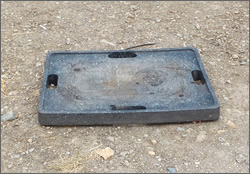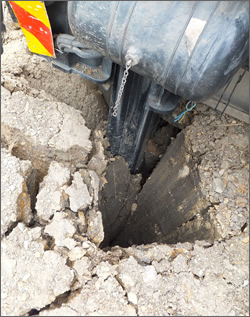Support of mobile plant on outriggers
Published: 22 December 2015
Updated: 3 August 2018
Purpose
The purpose of this safety alert is to highlight the potential risks associated with inadequate support under outrigger feet on mobile plant – particularly on poor ground, including fill.
Background
Many models of elevating work platforms (EWP), mobile cranes, concrete placement booms and telehandlers rely on safe support of outrigger feet to prevent the plant overturning. A number of incidents have occurred around Australia where mobile plant on outriggers has overturned. In 2015, a 70 metre travel tower EWP overturned, resulting in a fatality.
Contributing factors
There can be several reasons why this type of incident occurs, but they often include one or more of the following factors:
- Soft ground – as a result of fill, ground water, reclaimed ground.
- Ground subsidence caused by nearby excavations and trenches, underground services and close proximity to creeks and other water courses.
- The area of timbers or other pads under the outrigger feet not being adequate for the ground conditions.
- Outrigger feet not being level or timber or pads being slippery, contributing to feet slipping off the pads.
- Uneven pressure being applied to the ground, such as when outrigger pads or timbers bend.
- An increased loading on the outrigger when the boom is directly above it or the boom is being loaded.
- Sinking of an outrigger pad while the unit is being operated.
- Short-legging of an outrigger where the plant is not designed for short-legging.
Soft ground can be disguised by a relatively thin crust on the surface where the ground has dried out, however, under the surface crust the ground is still soft. The hard crust can give the false perception that the ground has adequate bearing capacity, but when the load on the outrigger increases, one of the feet can suddenly punch through the crust causing the plant to overturn. Photograph 1 is an example of an outrigger pad sitting on the ground where a crust has formed without any indication that the ground is soft (i.e. the pad has not sunk). Photograph 2 shows a view of an outrigger and pad that have punched through the crust deeply into the ground. Photographs 1 and 2 apply to the same incident scene.
 Photograph 1: Outrigger pad on fill with no visual signs that the ground is soft |  Photograph 2: Outrigger pushed into soft ground after breaking through crust of fill |
Action required
The operating instructions from the mobile plant manufacturer should always be followed. Manufacturers and/or their agents in Queensland have a duty to supply information on any conditions necessary to ensure the plant is safe, this includes information on the loads imposed on the ground by outriggers and wheels. Where the information is no longer readily available, a competent person such as a geotechnical engineer should be engaged to assist in developing appropriate information on ground support for the unit.
The person conducting the business or undertaking must provide operators with sufficient training instruction and supervision for them to make an informed assessment as to what ground support is required. This should include documented procedures for checking the outrigger packing based on the EWP specifications and site conditions. The procedures should reference the manufacturer's information on loading applied to the ground and the expected bearing capacity of the site. In some cases it may be necessary to request site specific information to ensure it is suitable for the plant that has been selected.
Once on site, if there are any doubts or obvious signs that the ground may be suspect (i.e. soft ground, fill, underground services, etc.), the operator should seek direction from their employer. There may be a need to engage the services of a competent person, such as a geotechnical engineer, to make an assessment of the ground and then to specify suitable control measures (i.e. ground preparation with crushed rock or the use of steel bog mats under the outrigger feet).
There is a particular need for caution where the ground is made up of fill. Indicators that the ground is fill include the presence of rubble (i.e. broken concrete, bricks, metal, timber) and that the ground doesn't appear to be natural. Where the ground is fill, the operator should not assume that just because there are no obvious signs that the ground is soft that it is able to safely support the plant.
Continual monitoring of outriggers during operation is needed so that the unit can be stopped if the outrigger or pads show any signs of sinking.
Further information
Further information can be obtained from the following:
- Mobile crane Code of Practice 2024 (PDF, 2.29 MB)
- Concrete pumping Code of Practice 2019 (PDF, 1.04 MB)
- Australian Standard AS 2550.10: Cranes, hoists and winches – Safe use – Mobile elevating work platforms